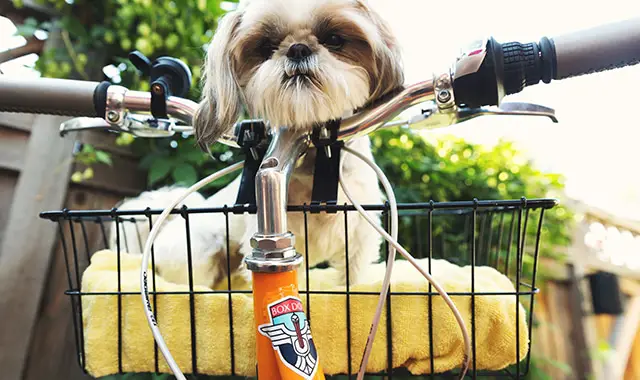
If you’re looking for a toy breed that’s full of personality and self-importance, it’s time to get to know the Brussels Griffon. Owners know these little pups for taking over the household and exerting influence well beyond their size. Let’s take a deeper look at this friendly looking toy breed.
The Brussels Griffon at a Glance
[table “BrusselsGriffon” not found /]Breed History
Brussels Griffon puppies have quite a history and it’s important to know because it explains some of the overall characteristics of the breed. Breeders developed the Brussels Griffon in Belgium as a ratter. Specifically, it worked in cities catching rats in stables of the horses that pulled public carriages. Historians did not keep records of the breed and are not sure of the exact lineage. The Brussels Griffon was created from a mix of:
- The Affenpinscher.
- The English Toy Spaniel.
- The Pug breeds.
Breeders gave the dog its own name in 1880. Owners bred this dog for competition only three years later!
Owners introduced this dog into England in the early 1890s. It’s popularity grew and owners created clubs specifically for this breed. Around this same time, Brussels Griffons had become the favorite dog of the Queen of the Belgians. They were being bred extensively in Belgium as well.
Brussels Griffon puppies first appeared in the stud books of the American Kennel Club (AKC) in 1899. Breeders showed this dog at Westminster in the miscellaneous category until they got their own classification in 1900. Love and support for the breed kept growing and they remain an important breed today. According to the AKC, the Brussels Griffon is currently the 97th most popular breed in the US.
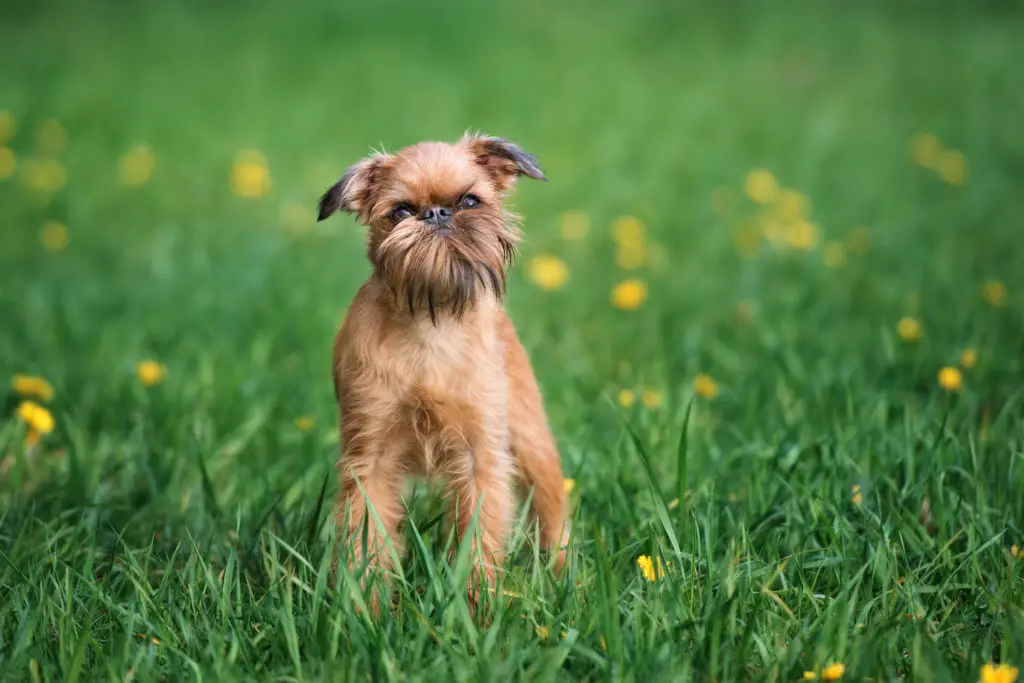
What were they Bred For?
Like many small dog breeds or toy breeds, they were originally bred to catch mice in city stables. Coachmen used them as ratters.
Physical Characteristics
Brussels Griffons are a toy breed with a square, sturdy build. They usually weight around ten pounds and appear very solid. They’re about eight inches high at the shoulder and have a bit of a broad stance for their size. Their natural tails are long and curved but are usually snipped to about a third of the size for show dogs. They have a steady, purposeful trot-like gait and walk smoothly and with purpose.
Size
The adult Griffon stands from 9 to 11 inches (23–28 cm) at the withers. They weigh 8 to 10 pounds (4–5 kg).
Head and Face
The head and face are one of the most important features of the breed because it’s what gives them their characteristic human-like expression. The essential feature is their large, friendly eyes which are wide set and in line with the nose. They’re very large, very dark in color, and appear very open and expressive. Their upturned jaw, domed forehead, and low-profile muzzle give them a very rounded, proportional look. Dogs with a short snout are flat-faced dogs or ‘brachycephalic’. Because of this special feature
Their small ears that sit pretty high on their heads. Sometimes, they’re cropped. If left natural, they have some lift but break right above the skull.
Coat
There are two different types of coat: smooth and wiry. The smooth coat is straight and short. There are no wiry hairs present and it has a glossy appearance. That’s basically the exact opposite of what the wiry coat looks like. None of the hair is glossy or silky. It’s actually dense and quite firm. The hair around the face is usually a bit longer and is often clipped to resemble a long beard.
Colors
They come in a few different colors: solid black; red with brown or black around the whiskers; belge, which is a mixture of red and black that usually has black around the face; and black and tan, black with uniform reddish tan marking around the face and legs.
Temperament
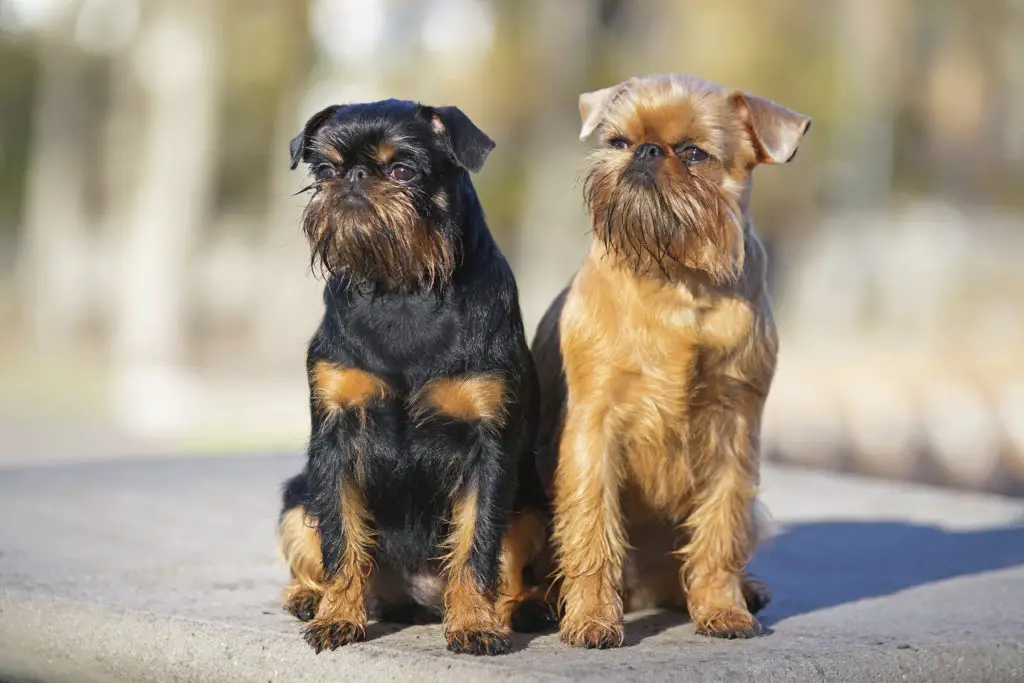
As far as personality, these are a confident breed with a lot of personality in a small package. They’re very intelligent. Owners describe them as self-important. They’re very sensitive and will remember being treated harshly. While they’re anxious to please their owners, they are also stubborn and don’t do anything they don’t want to do. When training these dogs, persistence, and kindness will pay off in the end.
Brussels Griffons make truly wonderful companion dogs. They love their people and will do anything to please them. Well, anything that they want to do. Training them can be a little difficult but with the right motivation, their will to please wins out.
What is the Best Climate for the Brussels Griffon?
One of the things that is so great about this breed is that they really can live just about anywhere as long as the temperatures are too extreme. They are flat-faced dogs or ‘brachycephalic’. Dogs with a short snout have a harder time breathing when they are extremely hot.
They’re just as suited for an apartment in a big city as they are to a farmhouse with a yard. Just make sure they get enough exercise and avoid hot weather and you’re good to go.
Are They Good for Families?
These dogs are good for families. They crave interaction which makes a family situation good for this dog. This dog will protect the family from rodents and intruders. Because they like to chase rodents, it’s best to keep any rodent, reptile, or any other small pet away from these dogs. These dogs do get along with other family pets like cats and dogs.
Are These Dogs Good For New Owners?
Griffons do best with an owner who doesn’t mind a dog that wants to be in on the action. This dog can be a very close companion. They love attention from the people they love and have been called “Velcro dogs” by some owners. If your Brussels Griffon is feeling ignored, he will do whatever he has to in order to get your attention—even if it means misbehaving.
Are They Social with Other People?
They are not aggressive but scare easily and have been known to bite when they’re afraid. Early socialization can help with this trait. Being exposed to other people, places, sights, and sounds can help a Griffon puppy grow up to be a more well-rounded pet.
They aren’t aggressive but they can scare easily and have been known to growl or snap when they’re afraid. This doesn’t mean that they can’t be in a home with small children, but they should always be supervised around new kids. Children should be discouraged from picking up the dog or forcibly holding or hugging it. Watch the dog and if he begins to appear scared or uncomfortable, put him in his crate or another quiet place where he’ll feel comfortable.
Do They Have a Strong Prey Drive?
These dogs do have a high prey drive for smaller animals like rodents but are OK with most other cats and dogs.
Health Issues
If you’re thinking about getting a Brussels Griffon puppy, make sure you get a healthy dog, which means starting with checking on the breeder. Make sure you go to someone reputable who will be able to give you information about the litter’s parents. Ask to see health clearances for the parents to make sure that they’ve been cleared of diseases that the breed is prone to. Some of these include:
- Eye Issues. Because their eyes are so prominent, they’re more prone to irritation.
- Hip dysplasia. This occurs when the thighbone doesn’t fit correctly into the hip joint. It’s hereditary but can also be caused by environmental factors, like excessive weight gain or fall injuries. This condition can be accompanied by pain or difficulty walking or you may not notice anything concerning. This condition can worsen as the dog gets older, especially if he also develops arthritis.
- Patella Luxation. The patella consists of the bottom of the thigh bone, top of the lower leg bone, and kneecap aren’t in proper alignment which causes the knee joint to rub together. The dog is born with this condition but it doesn’t always show up right away. It can result in pain, lameness, or an abnormal gait. Plus, the constant rubbing can lead to arthritis down the line. This condition is graded for severity and very intense cases may require surgical repair.
- Skin Allergies. If your Brussels Griffon is scratching or licking his skin and paws a lot, it’s time to take him to the vet.
How Long does the Brussels Griffon Live?
They have an impressive lifespan. They can live up to 15 years!
Do They Make Good Pets?
Now that you know more about the basics of the breed, how do you know whether or not a Brussels Griffon is right for you? Here are some things you need to know about caring for one.
These dogs are suited to city living and prefer being in the house. Because they don’t need a lot of room to run around, they’re a great apartment dog but would do just as well in a farmhouse.
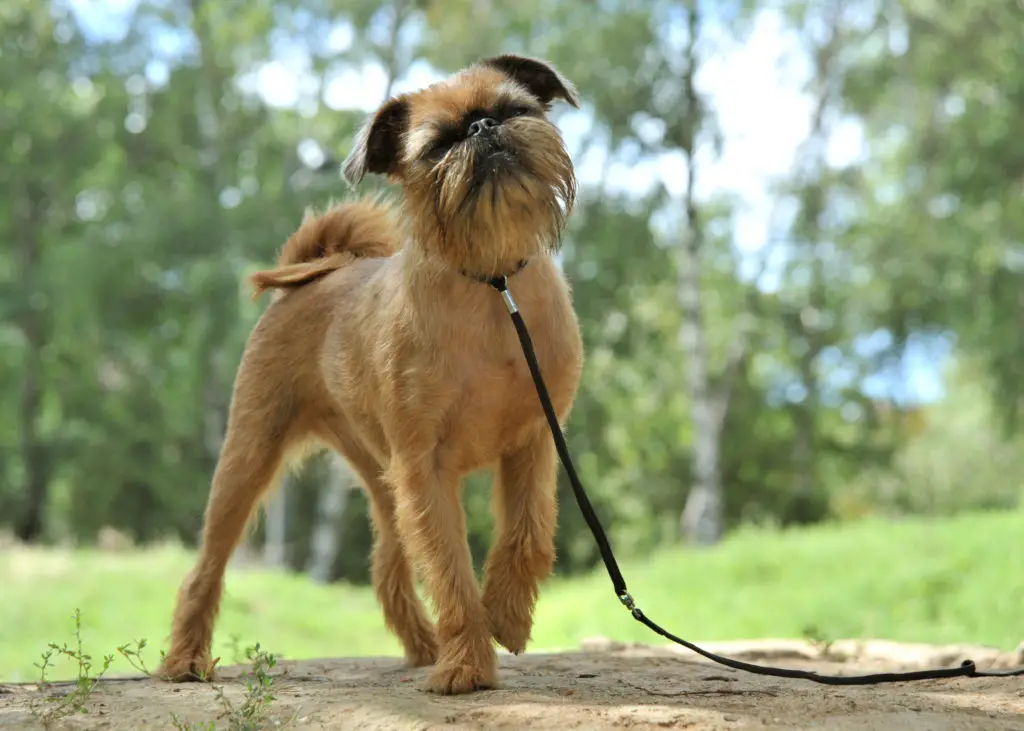
A yard is helpful to help them burn off energy and get exercise but it isn’t necessary as long as they get out on enough walks during the day.
How Energetic are They?
These dogs are very energetic. Fortunately they are also very small and a good walk daily or several times a day gets this dog a lot of good exersize.
How Trainable is the Brussels Griffon
Training Griffons is possible but it has to be done in the right way. They’re smart so they can learn new behavior but they have to be motivated to want to do it. They love attention and will likely respond to positive reinforcement rather than correcting his mistakes.
Grooming the Brussels Griffon
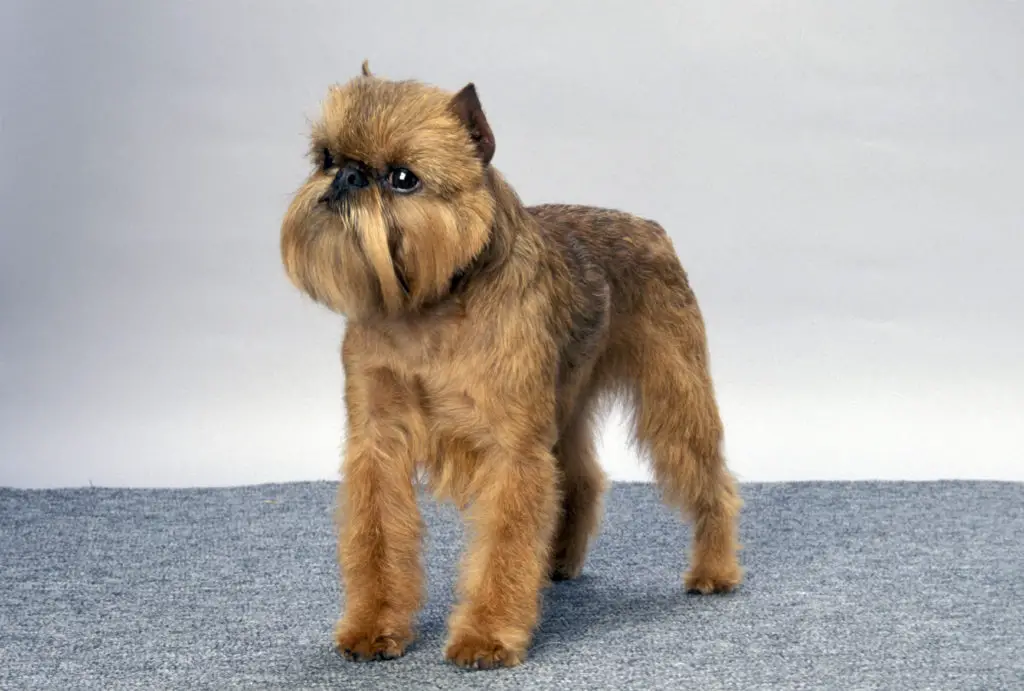
As for grooming, it depends on the coat. Wiry rough coats need brushing every week and then combed. They should also see a professional groomer twice a year for hand-stripping the rough coat. This reduces shedding and, believe it or not, is better for allergy sufferers than a short, clipped coat. Smooth coats need very little maintenance. Weekly brushing and a bath when needed is sufficient.
Taking Care of the Brussels Griffon’s Teeth
Teeth should be brushed two to three times a week to prevent gum disease and to help keep bad breath under control. Nails will need to be trimmed occasionally, about once or twice a month. A good rule of thumb is if you can hear a Brussels Griffon’s nails hitting the floor when he’s walking, it’s time for a trim.

One important thing to keep in mind is that the details we covered are true of the breed as a whole. As we mentioned, these dogs have huge personalities. Not all dogs conform to the breed standard. It’s really important to know what to expect from a dog but you should also be ready for anything, especially when it comes to a Brussels Griffon.





